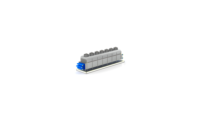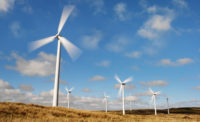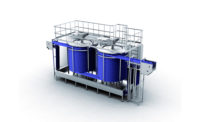Burning Questions for Higher Chilling Production

Traditionally, chilling and freezing have been labor and energy intensive processes, yet they are critical to producing consistent, high-quality products and brands. Freezing processes often receive first attention because of their operating costs and power consumption, but choices about chilling processes can be equally important.
While prepared food operations have traditionally relied on mechanical systems to freeze or chill, meat, poultry and seafood processing operations typically chill with ice or dry ice, often in totes, combo bins or mixers. Cryogenic chilling solutions, which typically use carbon dioxide (CO2) snow and liquid nitrogen (LIN), can offer a valuable labor- and power-conserving option that can also improve quality. Chilling during mixing, blending, conveying and packaging operations are usually ripe for improvement and technology upgrades.
Newer cryogenic options include automated and semi-automated systems for generating CO2 snow for mixing, blending and dry packing operations, as well as bottom-injection systems that can chill dough or even ground poultry from the bottom of mixers using liquid nitrogen or CO2. Pneumatic in-line chilling systems for the bakery can now control dry ingredients flowing to the mixer within +/-1oF.
Here are a few questions to consider, particularly as market needs change and chilling production demands grow:
What is the current cost-to-chill for each chilling production line?
It is important to establish a clear baseline for monitoring and management. Regular charting of throughput volume vs. input costs can signal areas for improvement. Measuring volume output is straight forward, and utility or cryogen consumption is typically the raw measure of input costs. There can be many variables, however, and further detail can be informative. If costs are rising, is it because the utility rates or production volumes went up, or is efficiency declining in some way, perhaps in combination with production increases?
What variables may be indirectly impacting chilling line productivity?
This may include:
- Increased labor and labor costs
- Unscheduled maintenance or downtime
- Product and quality losses
- Losses due to under- or over-weighting of packages
- Raw material or chilling losses
- Plant space or storage considerations
- Incoming product temperature
On this last point, products that come in warmer require more chilling, and incoming temperatures do vary, especially between product changeouts. These variables may influence one another, but spikes in one or more can mean the chilling process requires either an overhaul or an upgrade. The good news is that a significantly higher level of productivity is not only possible, but a likely result of moving up the process chilling chain. (See chart.)
Operations that rely on ice blocks or bagged ice, whether water ice or dry ice, are inherently labor intensive, require plant space for freeze storage and provide inconsistent product temperatures. Mechanical freezers and chillers are always energy intensive, and plant space is often at a premium particularly as market demands and production volumes grow.
There are other potential losses to consider. Water ice melts going from freezer to processing areas, and may also melt during loading, palletizing or transport, which could damage packaging or affect product quality. Solid CO2 sublimates into a gas, so it will never melt, but pellets can sublimate quickly at ambient temperatures resulting in yield loss and higher chilling costs. On-demand snow generation for process chilling eliminates storage costs and related losses altogether.
For products chilled with ice or snow in boxes, hand packing or manually directing ice into packages adds process variations that could impact consistency of product packing weight. And, uneven filling within any package or container means inconsistent chilling temperatures that could ultimately impact product quality. In the food industry, reputations can be won or lost on quality, so vigilance across production operations are always required, particularly when lines are approaching capacity.
Plant and worker safety are just as important as food safety. Yet physically moving bagged ice inside the plant, pouring heavy bags into mixers or totes and shoveling ice by hand can all mean more than just time and labor. They can also increase the chance of back and motion injuries. Dry ice and other forms of CO2 used for chilling can also be hazardous if worker processing areas are not properly ventilated. Shoveling CO2 pellets or snow into tote boxes or combo bins, particularly over prolonged periods, could cause asphyxiation in areas with inadequate ventilation.
Semi-automated and automated chilling equipment that use CO2 should be designed for cryogenic efficiency to maximize BTU transfer within the process, and waste gases should always be vented to the outside to establish a safe working environment. While liquid nitrogen is generally not used for most chilling processes, in recent years it has proven an effective alternative to CO2 in chilling ground meat and even poultry from the bottom of mixers in the bottom-injection process.
Improvements in chilling processes will always depend on multiple factors. But, asking the right questions and implementing needed changes early can keep operations running smoothly and quickly, leading to significant long-term gains.
Looking for a reprint of this article?
From high-res PDFs to custom plaques, order your copy today!







